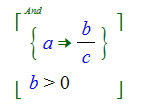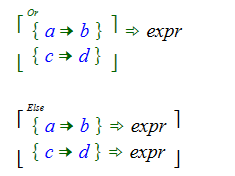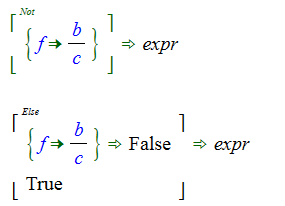The And, Or, and Not Objects for PatternMatching
There are two sets of And, Or, and Not objects defined. The first set represent the conventional Boolean objects. The second set is in the Code namespace and are used with pattern matching. These objects can take objects of type Boolean or PatternMatch as parameters. When the And, Or, and Not in the Code namespace contain multiple match objects, they build the appropriate cumulative binding list as the match expressions are executed.
The And Object
The And object in the Code namespace provides a convenient way to express a requirement that multiple expressions each match to a corresponding pattern. For example:

A Boolean expression is a subtype of a PatternMatch, so an And term can contain a combination of match objects and conventional boolean expressions. For example:

An And expression can also contain only Boolean expressions. In this case, there is no pattern matching and the behavior of the Code.And object is the same as the conventional Boolean And.
Note that an Assert expression containing an And term in the pattern match can be expressed in terms of nested Assert expressions. For example, these two clauses are equivalent:
And[ { a -> b }, { c -> d }] => expr
{ a -> b } => { c -> d } => expr
This means that varibles bound in a pattern match in the first term of and And expression can be used in a later pattern match in the And expression.
The Or Object
The Or object in the Code namespace provides a convenient way to express a requirement that at least one of several pattern match expressions must succeed. For example:

Like the And object, the Or object can also contain conventional Boolean expressions and behaves like the Boolean Or in this case.
Note that an Assert expression containing an Or term in the pattern match can be expressed as an ElseList of clauses. For example, these two clauses are equivalent:

Since each of the pattern match terms in the Or expression are evaluated separately, any variable bound in the first term of an Or expression are not carried over into later terms the way they are in an And expression.
The Not Object
The Not object succeeds if the PatternMatch in its parameter would fail to generate a match. The Not object always returns an empty binding list. The Not object is implemented by evaluating the PatternMatch object passed into its parameter. If that match returns one or more valid lists of bindings, then the Not fails. If the PatternMatch doesn't return any binding lists, then the Not succeeds. The following two clauses are equivalent and illustrate how the Not object is implemented:

A Not expression never generates any additional bindings to variables. For example, in the match expression:
Not[Match[x + y, a + b/c]]
the match succeeds, but it does not generate a binding between the variable "a" and "x".
The And, Or, and Not objects can be nested in a match expression when needed.
